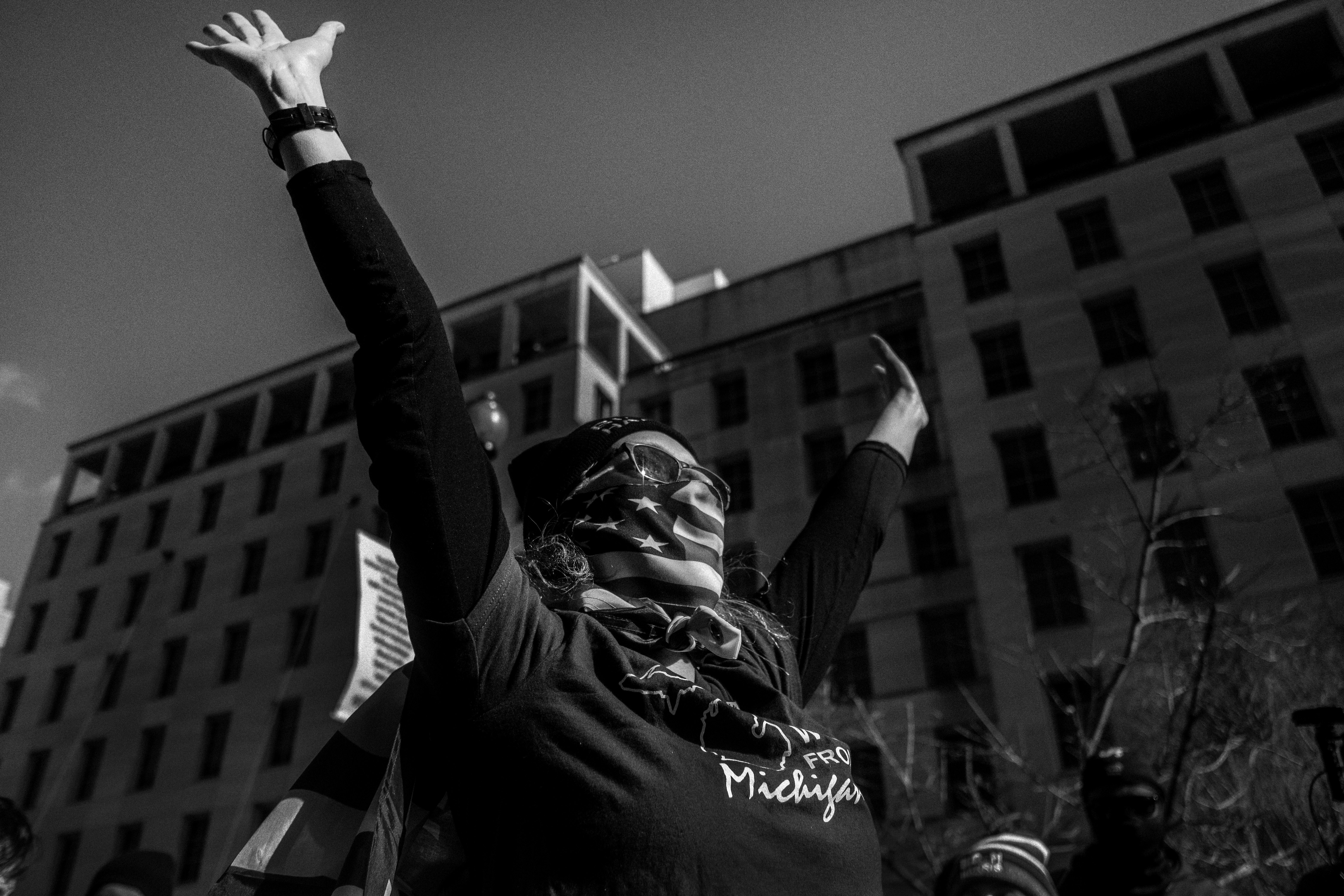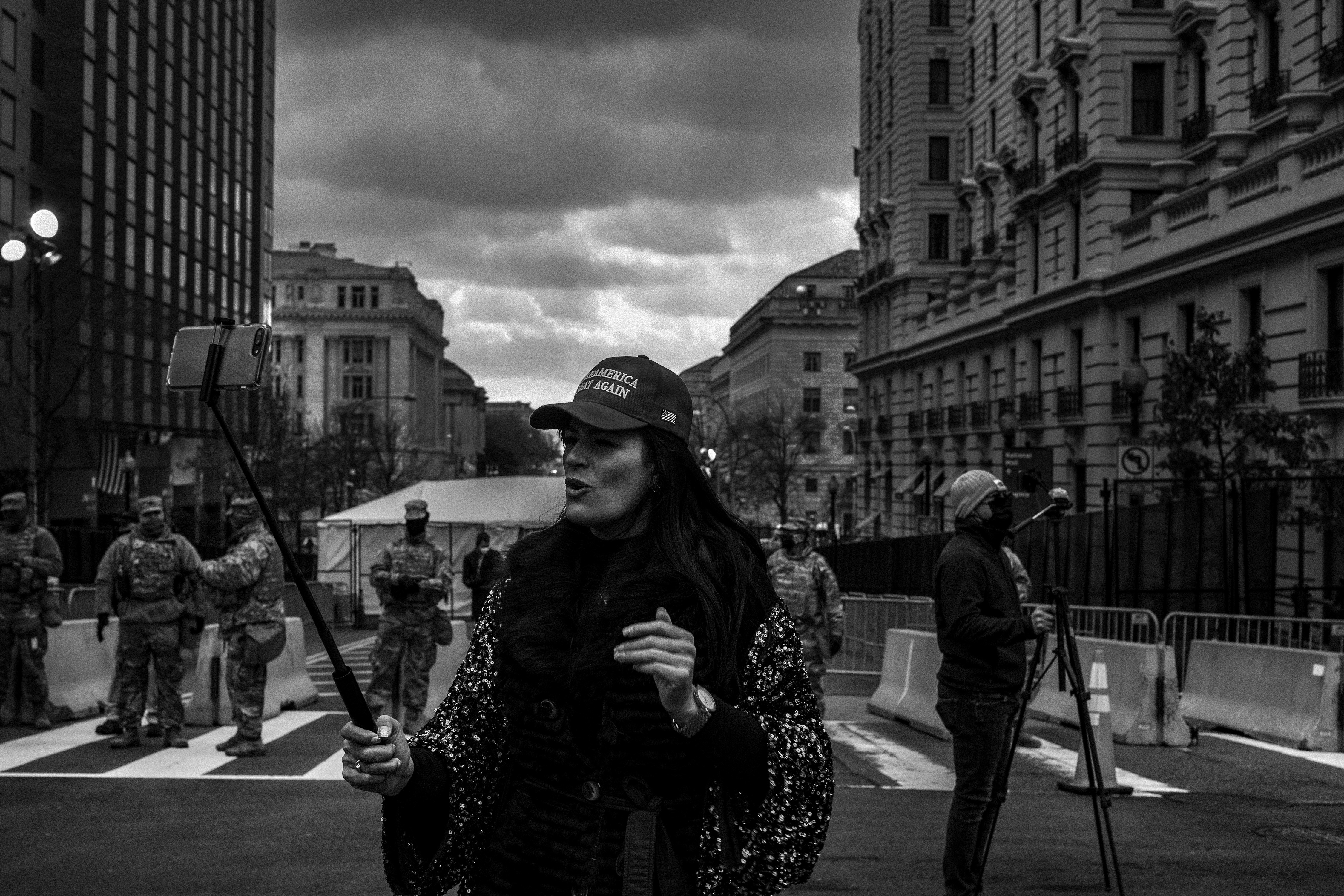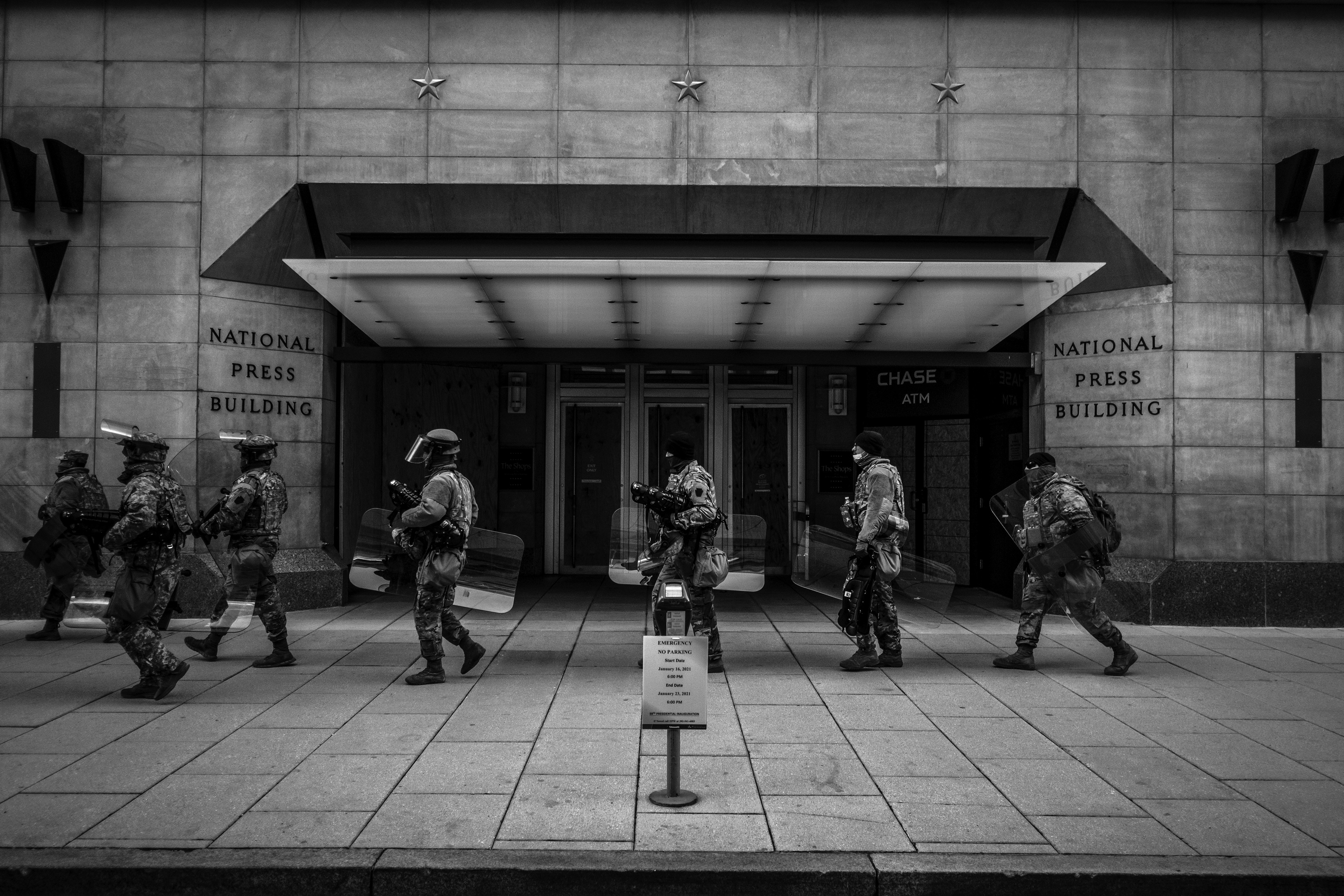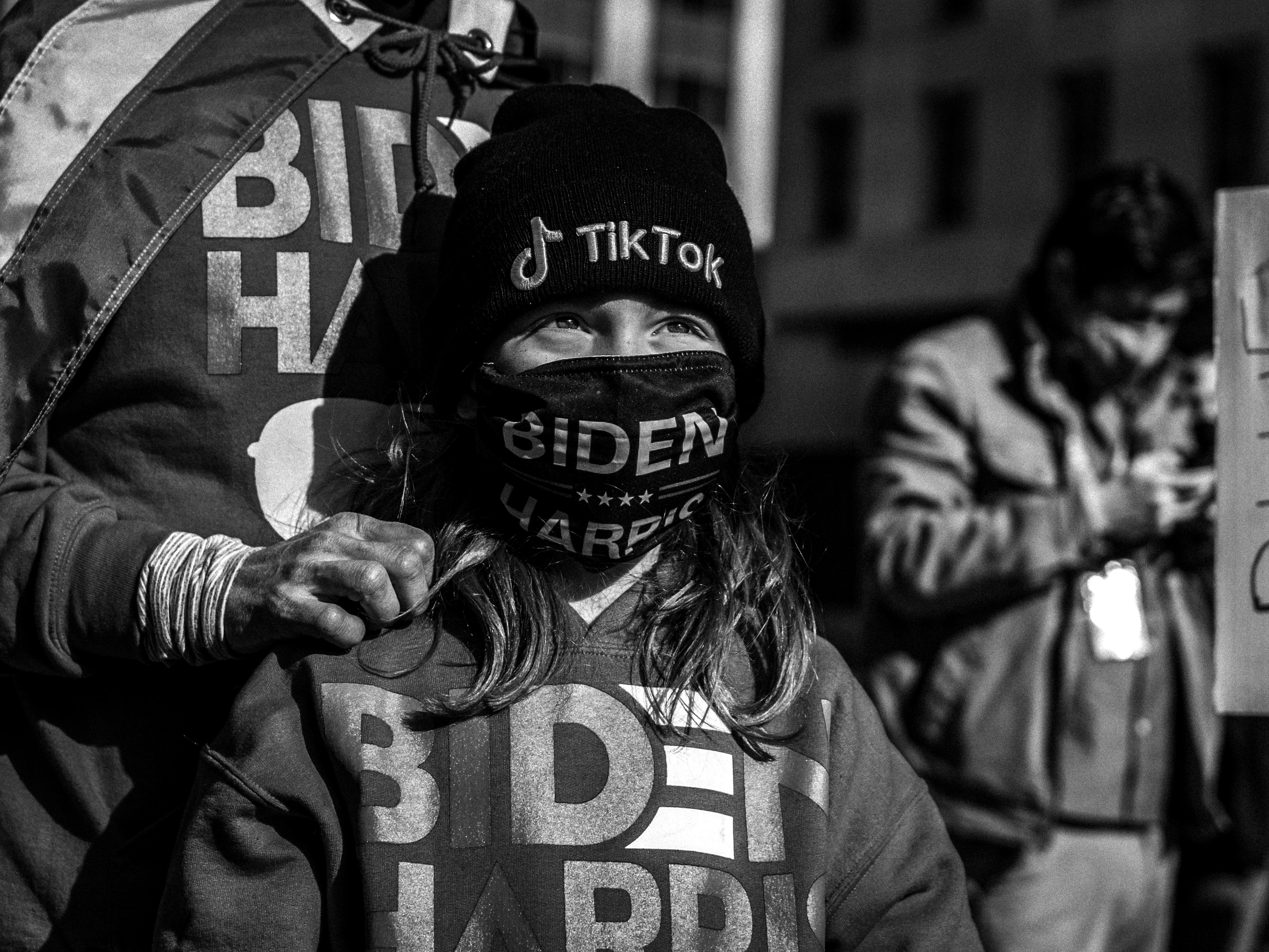The Intercept
January 20, 2021
ON INAUGURATION DAY, the streets of America’s capital were thronged with soldiers rather than civilians. But small groups of celebrators came out to see what they could, and they found what they needed.

People react as Joe Biden is sworn into office as president of the United States in Washington, D.C., on Jan. 20, 2021. Photo: Ron Haviv/VII/Redux for The Intercept
In a way, this was an intimate inauguration. There was no central mass of people gathered at one spot, cheering or laughing together. It was up to each individual, each modest assembly, to gesture or shout on their own, when and how they felt the urge. At Black Lives Matter Plaza in downtown Washington, photographer Ron Haviv, on assignment for The Intercept, caught people throwing their arms into the air in celebration, defiantly refuting everything that had happened in recent years, looking ahead to a future that, their fierce expressions seemed to say, has to be better than what they just endured, and will be better.

Tiffany Wade listens to President Joe Biden’s speech after he was sworn into office in Washington, D.C., on Jan. 20, 2021. Photo: Ron Haviv/VII/Redux for The Intercept
It was an inauguration characterized not by vastness but by distance, because it took place beyond the view of the relatively few people who were trying to catch a glimpse of it. There will be no polemics about the size of the day’s crowd, whether it was the biggest ever or not; there is a pandemic still with us, and two weeks ago, a mob stormed the Capitol. What the celebrators caught of the ceremony was enough, even if it was on a screen.
So it was for the young women who gathered at one of the dark fences that turned the center of Washington, D.C., into a maddening maze. One of them holds a phone in her ungloved hand; they all look intensely at it and despite their masks, you can see, or maybe sense, that there are smiles underneath. Haviv was a few feet from them, at the moment when the motorcade bearing Biden — he was now the president — rolled past. As with most of the day’s events, the motorcade was not visible at their spot, so what sufficed for these women was the sight of Al Roker on their handheld screen telling them what was going on just out of view. We love Al Roker, they agreed, holding their coffee cups.
The emptiness of the streets was not a void. The distanced inauguration allowed for the time and freedom to think without interruption, without the force of a crowd around you instructing you how to feel, filling you with its emotions. There was much to think about: the riot of January 6, the years and years of delusional mobs, the impassable fences of this day, the lines of soldiers, the quiet of an event that is not supposed to be quiet, America in 2021.


People wait to see President Joe Biden’s motorcade after he was sworn into office.Photo: Ron Haviv/VII/Redux
What was it like to be there, what ideas did the day generate? “Obviously, everyone wanted to be more safe than sorry, and we’re grateful that nothing happened,” said Akela Lacy, a reporter for The Intercept who covered the day’s events. “But the feeling of victory broadcast from the inauguration was in stark contrast with how the city felt all day: empty and eerily quiet, militarized, closed off, and with far more National Guard members, police, and press than members of the public. And with all that, it still didn’t feel totally ‘secure.’ The people of D.C. didn’t get to be part of this event today except through a screen. I think it just reflects how far we have to go to really move on from the events that started off the year, and makes me wonder what police presence in D.C. will look like in the future, and how it has and will impact people who keep the city running and weren’t part of the events today.”
It wasn’t just the troops who were a reminder of the brutal facts that a better-than-average inaugural speech could not wish away. While there was no violence on this day, there were a few people wearing the hats that we have not seen the last of, streaming their MAGA stories to followers across the nation. This day was not the occasion they had hoped for, but there are many days ahead that they hope to shape and own.

A lone Trump supporter during the inauguration of President Joe Biden in Washington, D.C., on Jan. 20, 2021. Photo: Ron Haviv/VII/Redux for The Intercept
It is impossible to stay away from the soldiers on the streets, visually or politically. After spending the past few years covering the U.S. government’s legal and physical crackdown on undocumented immigrants, The Intercept’s Ryan Devereaux could not ignore the men and women in uniform. “On this day, it was continually startling to see the level of militarization in the streets, to remember what had triggered it, and then to recognize that the anger and division that brought us to this moment wouldn’t end today.”


Top/Left: National Guardsmen move into new positions as they await the presidential motorcade to enter Washington, D.C., after visiting Arlington cemetery on Jan. 21, 2021. Right/Bottom: A Wells Fargo bank ATM is boarded up during the inauguration of Joe Biden in Washington, D.C., on Jan. 20, 2021. Photo: Ron Haviv/VII/Redux for The Intercept
The capital is filled with all kinds of headquarters and edifices, including the National Press Building, across the entrance of which a line of soldiers with riot shields marched on Inauguration Day. It was a moment to stop and think, because when the mob attacked the Capitol two weeks ago, they also attacked journalists who were trying to cover the day’s events. Enemy of the people, the mob shouted, repeating a line that they had learned from their leader.

National Guard troops move past the National Press Building in Washington, D.C., on Jan. 20, 2021. Photo: Ron Haviv/VII/Redux for The Intercept
There is no easy explanation for the day, no single picture that says it all or most of it all. There are, despite the formations of soldiers and the still-broken windows and doors at the Capitol, images of a girl like Lily Wade, who is 8 years old and wanted her mother to bring her to the inauguration to see Kamala Harris become the first woman vice president. Lily is from Alabama. Where is she looking? Ahead, into the distance, the future.

Tiffany Wade’s daughter Lily, 8, listens to President Joe Biden’s speech. Lily asked her mother to be able to witness history and attend Kamala Harris’s inauguration as vice president. Photo: Ron Haviv/VII/Redux for The Intercept
